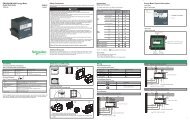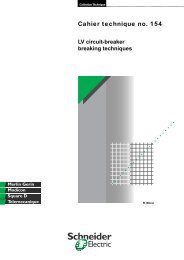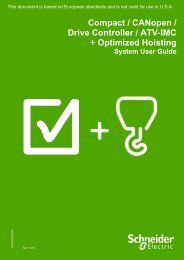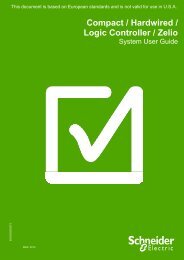Cahier technique no 195 - Schneider Electric
Cahier technique no 195 - Schneider Electric
Cahier technique no 195 - Schneider Electric
Create successful ePaper yourself
Turn your PDF publications into a flip-book with our unique Google optimized e-Paper software.
Current transformers:specification errors and solutionsAfter a reminder of current transformers (CTs), the author highlights theerrors most often encountered when defining current transformers, anessential and little k<strong>no</strong>wn link between the electrical network and theprotection relays.It explains how to find a way out of difficult situations: CTs that can<strong>no</strong>t bemanufactured, delays, additional costs, malfunctions, etc.This <strong>Cahier</strong> Technique should be useful for electricians designinginstallations, for protection specialists, panel builders and all CTmanufacturers. It is in the best interest of all to exchange all informationrequired for the safety and optimisation of CTs.This <strong>Cahier</strong> Technique is an operational addition to <strong>Cahier</strong> Technique<strong>no</strong>. 194 “Current Transformers: how to specify them”.Contents1 Specifying current transformers 1.1 Introduction p. 4properly1.2 Reminder of CTs p. 42 Examples of specification errors 2.1 Optimisation and safety p. 72.2 When CTs do <strong>no</strong>t seem to be suitable… p. 82.3 The most frequent errors p. 92.4 And if the CT can<strong>no</strong>t be manufactured? p. 123 Equivalence of the various possible 3.1 How to move from P n1 -5Pk 1 to P n2 -5Pk 2 p. 15definitions of the same CT3.2 How to move from P n1 -5Pk 1 to P n2 -10Pk 2 p. 153.3 What is the V k of a CT: P n -XPk p. 163.4 How to move from class X (V k , R ct ) p. 16to a class 5P: P n -5Pk4 Conclusion p. 175 Bibliography p. 18<strong>Cahier</strong> Technique <strong>Schneider</strong> <strong>Electric</strong> <strong>no</strong>. <strong>195</strong> / p.3
















